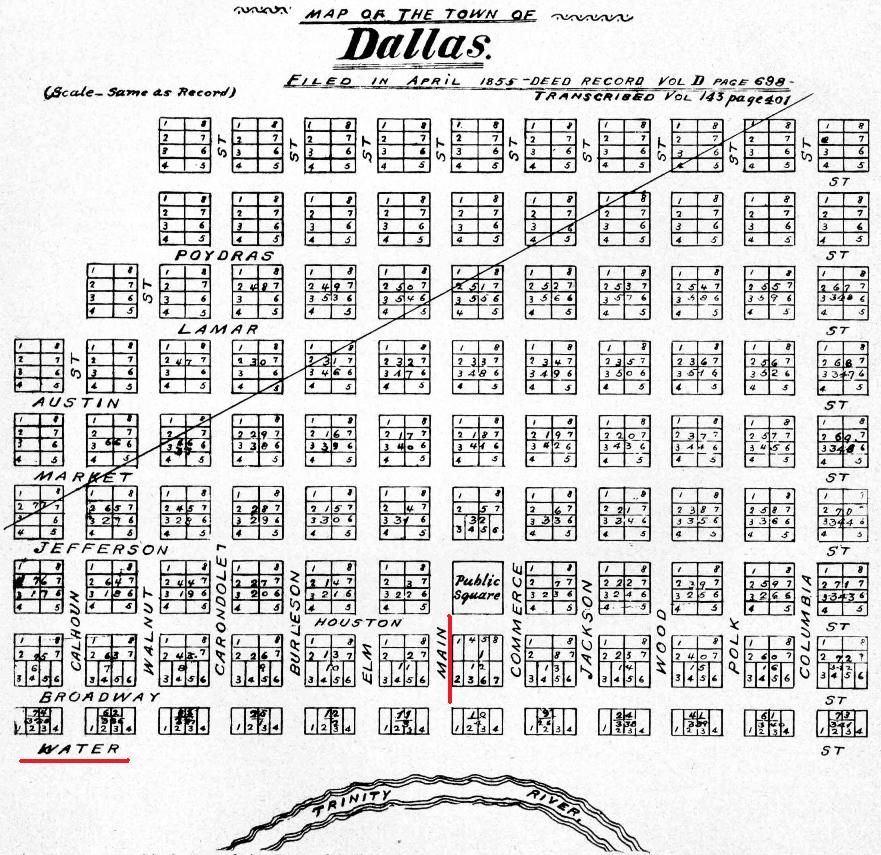Greg -
Do you still have the photo of the Dallas Terminal Company Bridge plaque and the map showing the old river bed immediately below the triple underpass?
This is the pre-railroad 1854 Plat Map. When Union Station was completed about 1916 most of the tracks were laid down what was then Broadway. To my knowledge nothing had ever been built on Water Street except perhaps for the toll collector's house. The buildings between Broadway and Houston were razed in 1935 to create the slope of the streets for the underpass.
![]()
I don't recall offhand the construction process of tunneling under the tracks to build the roadways. Did the railroad operations continue uninterrupted?
Several years ago you raised the issue of similarities between Dallas and Van Buren Arkansas. While there is no evidence Bryan was directly involved in the development of that town he was a business associate of the founders, David Thompson and John Drennan, and their acquaintance goes back to Bryan's birthplace in Fayetteville, Tennessee when he was still a teen. His journey west followed their route just a few years later
Bryan was surely influenced by them as they also started with a commercial enterprise (supplying firewood to the riverboats - Bryan operated a trading post) on the river then became land developers. One of their first acts was to donate the site for a courthouse to guarantee the selection of the fledgling town as county seat just as Bryan did in 1850 to sway the second election in Dallas. Bryan went one better by also donating 98 town lots.
I recently laid out early maps of the two towns. The orientation of the streets to the river is almost identical, as is the orientation of the river to the cardinal directions. As you suggested there were several street names common to both towns.
Another item I have found is that Drennan founded the Chihuahua Trading Company in 1839 and dispatched a party of men westward along Red River following the footsteps of Josiah Gregg the year before. One or the other might account for Bryan's first visit to Holland Coffee and the Three Forks, reported in most accounts as 1839.
M C
Do you still have the photo of the Dallas Terminal Company Bridge plaque and the map showing the old river bed immediately below the triple underpass?
This is the pre-railroad 1854 Plat Map. When Union Station was completed about 1916 most of the tracks were laid down what was then Broadway. To my knowledge nothing had ever been built on Water Street except perhaps for the toll collector's house. The buildings between Broadway and Houston were razed in 1935 to create the slope of the streets for the underpass.

I don't recall offhand the construction process of tunneling under the tracks to build the roadways. Did the railroad operations continue uninterrupted?
Several years ago you raised the issue of similarities between Dallas and Van Buren Arkansas. While there is no evidence Bryan was directly involved in the development of that town he was a business associate of the founders, David Thompson and John Drennan, and their acquaintance goes back to Bryan's birthplace in Fayetteville, Tennessee when he was still a teen. His journey west followed their route just a few years later
Bryan was surely influenced by them as they also started with a commercial enterprise (supplying firewood to the riverboats - Bryan operated a trading post) on the river then became land developers. One of their first acts was to donate the site for a courthouse to guarantee the selection of the fledgling town as county seat just as Bryan did in 1850 to sway the second election in Dallas. Bryan went one better by also donating 98 town lots.
I recently laid out early maps of the two towns. The orientation of the streets to the river is almost identical, as is the orientation of the river to the cardinal directions. As you suggested there were several street names common to both towns.
Another item I have found is that Drennan founded the Chihuahua Trading Company in 1839 and dispatched a party of men westward along Red River following the footsteps of Josiah Gregg the year before. One or the other might account for Bryan's first visit to Holland Coffee and the Three Forks, reported in most accounts as 1839.
M C